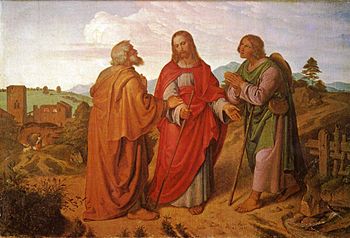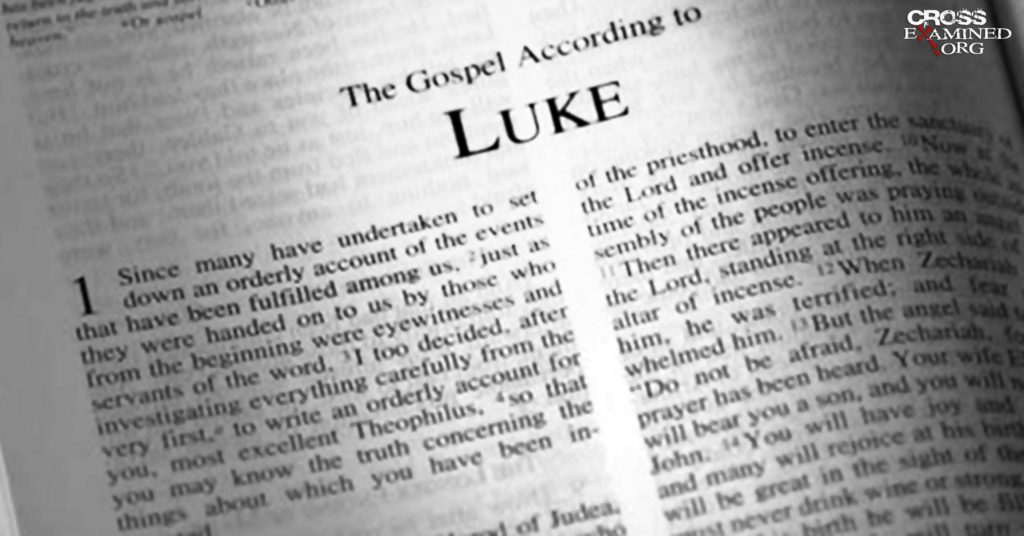Hope Lost and Regained
Luke’s version of the resurrection of Jesus can be found in Luke 24. Even though Jesus had repeatedly predicted His resurrection, no one understood it or believed it the way He intended. In Luke 9:22 and 18:32-33, Jesus had told His disciples, “The Son of Man must suffer…and be killed, and on the third day be raised up.” After he said this the next verse tells us that, “they understood none of these things, and they did not comprehend.” Apparently they had always been told the Messiah was coming to set up the Kingdom of God, and they were presupposed that this is what Jesus was talking about. Back to Luke 24:21, on Sunday morning after the crucifixion when the disciples were expressing their disappointment, they said “it is the third day” and there is no Kingdom. It appears they interpreted Jesus’ three day reference to setting up the kingdom. At that time (the third day), they still did not understand the necessity of His death or the reality of His resurrection. Remember that as late as the “last supper” they were arguing over which of them would be the greatest in the Kingdom (Luke 22:24). This is interesting because critics have always said the disciples made up the resurrection—How could they make up something they never even thought of or expected?
Three Parallel Stories in Luke 24
Luke 24 recounts three episodes all structured the same way, and telling the same story. In each the disciples are bewildered, then rebuked, then given instruction, and then are witnesses of the resurrected Christ. In verse 1-11, the women are bewildered at the empty tomb, then rebuked and given instruction by the angel.

In v.13-35, the disciples on the road to Emmaus are perplexed, then rebuked by Jesus and given instructions, and finally Jesus appears to the disciples back in the closed room in Jerusalem.
The Empty Tomb
In their rush to get Jesus buried before the Sabbath which began at 6:00 PM, Joseph and Nicodemus had wrapped Jesus up in linen wrappings and 100 pounds of myrrh and aloes (Jn.19:39) and hastily laid Jesus in the tomb. Matthew 27 adds that a large stone was rolled in place against the entrance, then the authorities sealed it and placed guards there. The women all witnessed this, but were not given their opportunity to anoint the body with spices and perfumes as they desired to do. Therefore they returned to the tomb Sunday morning to try and do so, only to find the stone rolled away, and the tomb empty. Luke 24:4 tells us they were perplexed about this, then unexpectedly two angels appeared to them shining in the dazzling glory of God. Naturally the women were terrified and fell to the ground. The angels then gently rebuked them with that famous line we hear every Easter, “Why do you seek the living One among the dead? He is not here, but He has risen.” The angel went on to instruct them about how Jesus had taught them about the resurrection. Naturally, they were very excited so they returned and told all these things to the apostles. In John 20:3-10, John adds that Peter and John ran to the tomb to verify the women’s account, and even though the tomb was empty, “they did not understand the Scripture that He must be raised again from the dead.” It is helpful to know that in first century Jerusalem, women were not allowed to be official witnesses, maybe this explains the reaction of the apostles in Luke 24:11, “these words appeared to them (the men) as nonsense, and they would not believe them.” I find it interesting that in spite of the traditions of men, God used these ladies as the first witnesses of the resurrection. It appears that God delights in confounding the traditions of men all through the Scriptures. This also tells us that no ancient person making up such a story would use women, only God would do it this way.
Classic Critical Explanations for the Empty Tomb
- The Swoon Theory—Jesus did not die, He was only unconscious and later revived.
Refutation: A professional soldier pierced His side with a large spear and all His bodily fluids poured out, and the soldier pronounced Him dead. Joseph and Nicodemus examined the body, concurred that He was dead, and wrapped the body in linen cloths and 100 pounds of myrrh and aloes. Even if He somehow was still alive after losing all his blood, how could He unwrap Himself, move the massive sealed stone, and walk by all the guards unnoticed?
- Wrong Tomb Theory—they all went to the wrong tomb.
Refutation: They all watched where He was placed. The women all went there, later John and Peter, and the authorities agreed Jesus’ tomb was empty along with the soldiers. The moved stone and the broken seal were identified as the tomb of Jesus.
- The Disciples Stole Jesus’ Body—This was the explanation of the chief priests who conspired with the elders and soldiers to cover-up the resurrection.
Refutation: The tomb was well guarded and sealed. The enemies of Jesus had no motive for removing the body, and the friends of Jesus had no power or intention to do so. The disciples had all denied Him and were hiding in fear. This lie would have had to have hundreds of people in on it so how could the disciples have perpetuated such a lie? All the disciples died a martyr’s death—who would die for such a lie?
Jesus Incognito
Luke alone records the story of the two disciples on the road to Emmaus. These two were walking slowly and hopelessly away from Jerusalem on Sunday afternoon. Even though they had heard Jesus say many times over the last year that He must be killed in Jerusalem but then rise again on the third day, His words had fallen on deaf ears. Add to Jesus’ teaching the Sunday morning reports that the tomb was empty and angels had proclaimed He was risen, and their state of mind is all the more perplexing to us as students. Apparently all of Jesus’ disciples were so expecting the Kingdom that they could not comprehend the necessity of the substitutionary sacrifice of Jesus or His resurrection. John’s Gospel used the story of doubting Thomas to teach this, and Luke used the road to Emmaus story. Since they were all confused and slow to believe they certainly could not have made up the resurrection. In Luke 24:13-35, the two disciples are walking away from Jerusalem on their way to Emmaus which was about 7 miles away. Three times Luke reports that they were deep in conversation about the events surrounding Jesus over the last week. They were “conversing”, “discussing”, and “exchanging ideas”. They were looking for explanations and answers to their confusion. While they were walking and talking, Jesus (incognito) came walking up from behind them and joined in their hike as well as their conversation. Verse 16 says that they were prevented from recognizing Jesus. There are at least four possible explanations for this: divine intention, the state of their mind, Satanic blinding, and Jesus disguised Himself. I think all of these are true. It was God’s sovereign purpose to reveal Jesus at just the right time, and in their state of mind they were not expecting or able to believe in the resurrection without some divine help. The last thing Satan wanted was for them to believe in the resurrection. I love the irony in verse 18 when the disciples accuse Jesus of not knowing about what happened in Jerusalem in the last few days. In fact, JESUS WAS THE ONLY PERSON WHO DID KNOW WHAT HAPPENED. Nevertheless, it was Jesus’ intention to use diagnostic questions to draw out their confused unbelieving state of mind, so He asked them what had happened. Their answer in v.19-21 revealed who they thought Jesus was and why they thought He came. At this point they still thought Jesus had come to “redeem Israel” and set up the Kingdom. I think they misinterpreted Jesus’ teaching about the “third day” (Luke 24:21) to mean the Kingdom would be set up on the third day.
Illuminating the Truth
Jesus proceeded to rebuke their ignorance and unbelief, and explain the necessity for His death and resurrection by using the Scriptures “beginning with Moses and with all the prophets”. Jesus pointed out how He had fulfilled hundreds of prophecies about the Messiah and God’s plan of redemption for mankind by coming into the world through the incarnation, living a sinless life, and then dying for our sins. All of Scripture, Jesus’ teaching, and the efficacy of God’s plan to redeem us is vindicated by the resurrection. Now we could know that because Jesus lives, we also will live eternally. The story climaxed in v.30-31 when Jesus went to their home to eat with them. As Jesus broke the bread and handed it to them, they saw the wounds in His hands, and “their eyes were opened and they recognized Him” as the risen Lord. In v.32 we see that God’s method of revealing truth is by both instructing our mind through Scripture, and the illumination of the Holy Spirit within our hearts. For all of us the risen Christ causes a reinterpretation of Scripture as Jesus informs our minds and touches our hearts.
CHARLIE TAYLOR
Lesson 10: Fall 14 Lesson 10
Lesson 10 Podcast:
Podcast: Play in new window | Download

